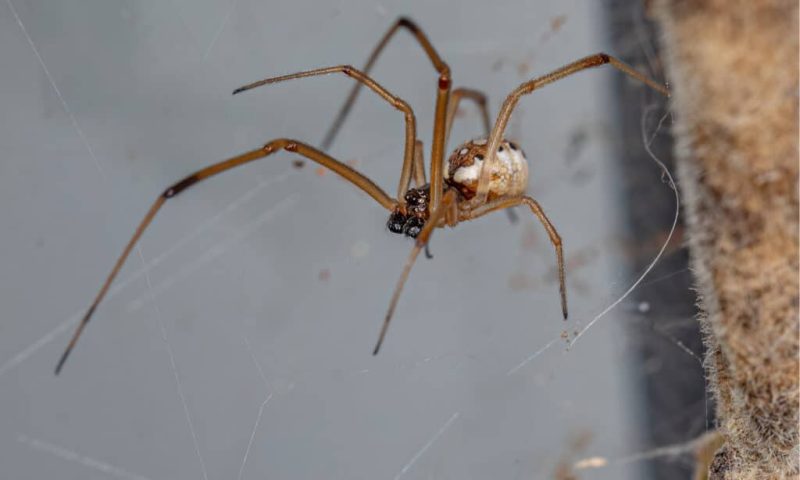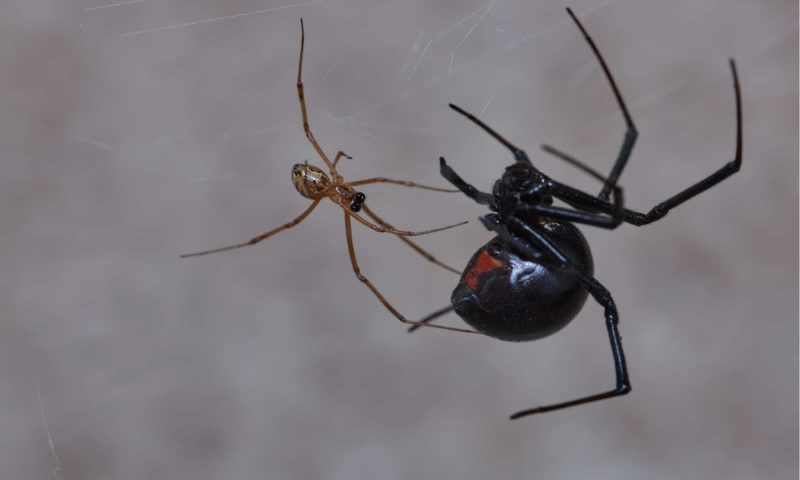The male black widow spider is a lesser-known counterpart to the infamous female, often overshadowed by the myths and fear surrounding its more venomous partner. Despite the dramatic reputation of black widow spiders, males play an important role in the species’ survival, yet they remain elusive and misunderstood.
In this guide, we explore the truth about male black widow spiders, covering their appearance, behavior, life cycle, mating habits, and more.
What is a Male Black Widow?

A male black widow is the male version of the Latrodectus genus, which includes several species of black widow spiders. Unlike females, male black widows are significantly smaller and are rarely seen due to their secretive nature. Their role primarily revolves around mating, after which they often face an unfortunate end.
While both males and females belong to the same species, they differ greatly in size, appearance, and behavior. Understanding these differences is crucial for accurate identification and appreciation of their ecological role.
Male Black Widow Appearance
Size and Body Structure
Male black widow spiders are notably smaller than females. They typically measure only 3 to 6 millimeters in body length, whereas females can reach up to 13 millimeters. Males are lighter, leaner, and less intimidating in appearance. Their legs are long and slender, which helps them move quickly when seeking a mate.
Coloration and Markings
Unlike the iconic shiny black body of the female, male black widows are often light brown or grayish. They may display faint red or pink markings, sometimes including spots or stripes along the abdomen. While some males possess the characteristic red hourglass shape on the underside of their abdomen, it’s usually less vivid or even incomplete.
Web Structure
Males do not typically spin the same large, chaotic webs as females. Instead, they create smaller and less noticeable webs or use the webs of females when searching for a mate. Their primary concern is not building a trap for prey but rather locating females for reproduction.
Male vs Female Black Widow: Key Differences

Size Comparison
One of the most striking differences between male and female black widows is their size. Females are often two to three times larger than males, with a more robust and rounded abdomen. This size difference is known as sexual dimorphism, which is common among spiders.
Color and Pattern
Females are glossy black with a vivid red hourglass marking. Males, on the other hand, are lighter in color and may have less distinct markings. Their less intimidating appearance often leads to them being overlooked or misidentified.
Behavior and Activity
Male black widow spiders are more mobile and active than females, especially during the mating season. While females tend to remain within their webs, males wander in search of mates, often putting themselves at risk in the process.
Life Cycle of a Male Black Widow
Egg to Spiderling
The life of a male black widow begins like any other spider, as an egg. After hatching, spiderlings are extremely small and go through several molts as they grow. During this stage, males and females look similar, making them hard to distinguish.
Maturity and Lifespan
Males mature faster than females, usually reaching adulthood in two to four months. Once mature, their main objective becomes finding a mate. Unfortunately, male black widows typically live only a few months as adults, often perishing shortly after reproduction.
Mating Behavior and Cannibalism
Courtship Rituals
Male black widows approach females cautiously, performing elaborate vibrations on the female’s web to announce their presence. These vibrations help prevent the female from mistaking them for prey. If the female is receptive, mating takes place.
Sexual Cannibalism: Fact or Fiction?
One of the most well-known facts about black widow spiders is that the female may eat the male after mating. While this behavior has been observed, it is not as common as popular culture suggests. In many cases, males manage to escape unharmed, especially in natural environments.
Post-Mating Fate
Even if the male is not eaten, he usually dies shortly after mating due to exhaustion and natural causes. His brief life underscores his singular biological purpose — reproduction.
Habitat and Range
Natural Habitat
Male black widow spiders inhabit the same environments as females, including woodpiles, sheds, basements, and dark crevices. However, because they do not build prominent webs, they are less likely to be noticed.
Geographic Range
Black widow spiders, including males, are found throughout North and South America, southern Europe, Africa, Asia, and Australia. In the United States, they are especially common in the South and West.
Diet and Feeding Habits
What Do Male Black Widows Eat?
Like females, male black widow spiders are carnivorous. However, their smaller size means they consume smaller prey. Their diet typically includes ants, small flies, and other tiny insects.
Hunting Behavior
Males are less active hunters than females. Because they focus more on finding a mate, they may consume less food during adulthood. They are opportunistic feeders and rely on their mobility to find food when necessary.
Predators and Threats
Natural Enemies
Male black widows face numerous predators, including birds, lizards, wasps, and larger spiders. Their small size makes them especially vulnerable in the wild.
Human Threats
Although male black widows are not dangerous to humans, they are often killed on sight due to mistaken identity. Many people are unaware that males are far less venomous and pose virtually no threat.
Are Male Black Widow Spiders Dangerous?
Venom Potency
Male black widow spiders do possess venom, but in much smaller quantities than females. Additionally, their fangs are not strong enough to penetrate human skin effectively. As a result, bites from male black widows are extremely rare and typically harmless.
Medical Relevance
Unlike females, male black widow bites do not require medical attention in most cases. In the rare event of a bite, symptoms are usually mild and include slight redness or swelling. Severe reactions are exceedingly uncommon.
How to Identify a Male Black Widow Spider
Key Identification Traits
To identify a male black widow, look for the following features:
- Smaller body size (3–6 mm)
- Light brown, tan, or grayish coloration
- Faint or broken hourglass marking
- Long, thin legs
Visual Guides and Pictures
Using a visual guide can be extremely helpful when trying to identify male black widows. Pictures often show the contrast between male and female coloration and size. Be sure to examine markings carefully, especially the underside of the abdomen.
Misconceptions About Male Black Widows
Myth: All Black Widows Are Deadly
Not all black widow spiders pose a serious threat. Males are often harmless and should not be feared. Their small size and weak venom make them insignificant in terms of danger to humans.
Myth: Male Black Widows Always Die After Mating
While it’s true that many males die after mating, not all are consumed by the female. In fact, cannibalism is less common in natural settings and is more often observed in captivity or under stressful conditions.
Importance of Male Black Widows in Ecosystems
Despite their brief and understated lives, male black widow spiders play a crucial role in reproduction and population stability. Their presence ensures the continuation of the species and contributes to the natural control of insect populations.
They also serve as prey for a variety of other animals, thus contributing to the food web in their ecosystems. Appreciating their role helps balance our understanding and respect for these often-misunderstood arachnids.
Final Thoughts
The male black widow spider may not be as infamous as the female, but its role is just as essential. Often overlooked and misunderstood, these small arachnids are fascinating in their own right. From their unique appearance and short lifespan to their critical role in mating and reproduction, male black widows are a vital piece of the natural puzzle.
Understanding the truth about male black widow spiders helps dispel fear and promotes a more balanced perspective on spiders in general. By learning to identify and respect them, we can coexist more peacefully with these important creatures of the natural world.






